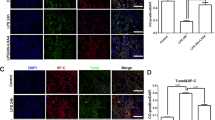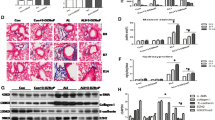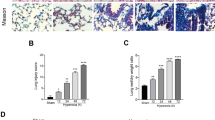Abstract
Purpose
Acute lung injury (ALI) with high rates of morbidity is often accompanied by the apoptosis in the type I alveolar epithelial cells (ATIs). Thus, the transdifferentiation of type II alveolar epithelial cells (ATIIs) into ATIs is crucial for the maintenance of alveolar epithelial functions. We aimed to elucidate the role of sesamin in the transdifferentiation of ATIIs to ATIs and the involvement of the TRPV1/AKT pathway.
Methods
In vivo, the mouse model of ALI was simulated by intraperitoneal and intratracheal injections of lipopolysaccharide (LPS), respectively. The protective effects of sesamin on ALI were investigated using the survival rate, lung/body weight ratio, histological analysis of lung with HE staining, and mRNA levels of inflammatory factors. Western blot analysis and immunofluorescence detection of ATIs marker AQP5 were used to evaluate the protective effect of sesamin on ATIs. Western blot, EdU, and qPCR analyses were applied to detect changes in apoptosis, proliferation, and transdifferentiation markers of ATII A549 cell lines. Small interfering RNA (siRNA) was used to detect the involvement and relationships between the sesamin receptors (ANXA1 and TRPV1) and the AKT pathway in transdifferentiation.
Results
Sesamin (200 mg/kg) significantly improved LPS-induced ALI and inhibited LPS-induced ATIs reduction. A low concentration of sesamin (20 μM) promoted the transdifferentiation of ATIIs to ATIs. Both ANXA1 and TRPV1 were involved in sesamin-promoted transdifferentiation, while the P-AKT (S473) level was down-regulated by TRPV1 siRNA.
Conclusion
Sesamin may promote transdifferentiation of ATII to ATI to ultimately rescue ALI, with TRPV1/AKT pathway involved in this transdifferentiation. This study revealed a novel role of sesamin in promoting the transdifferentiation of ATIIs to ATIs, providing experimental supports for the potential targets of ALI therapy.
Graphical abstract








Similar content being viewed by others
Abbreviations
- AKT:
-
Protein kinase B
- ALI:
-
Acute lung injury
- ANXA1:
-
Annexin A1
- AQP5:
-
Aquaporin-5
- ATIs:
-
Type I alveolar epithelial cells
- ATIIs:
-
Type II alveolar epithelial cells
- CFTR:
-
Cystic fibrosis transmembrane regulator
- DMSO:
-
Dimethyl sulfoxide
- LPS:
-
Lipopolysaccharide
- PDPN:
-
Podoplanin
- RAGE:
-
Advanced glycosylation end product-specific receptor
- SFTPC:
-
Surfactant protein C
- TRPV1:
-
Transient receptor potential vanilloid 1
References
Johnson ER, Matthay MA (2010) Acute lung injury: epidemiology, pathogenesis, and treatment. J Aerosol Med Pulm Drug Deliv 23(4):243–252
Ng CS et al (2006) Inflammatory response to pulmonary ischemia-reperfusion injury. Surg Today 36(3):205–214
Butt Y, Kurdowska A, Allen TC (2016) Acute lung injury: a clinical and molecular review. Arch Pathol Lab Med 140(4):345–350
Dobbs LG et al (2010) The great big alveolar TI cell: evolving concepts and paradigms. Cell Physiol Biochem 25(1):55–62
Evans MJ et al (1975) Transformation of alveolar type 2 cells to type 1 cells following exposure to NO2. Exp Mol Pathol 22(1):142–150
Kondo H et al (2015) Differential regulation of gene expression of alveolar epithelial cell markers in human lung adenocarcinoma-derived A549 clones. Stem Cells Int 2015:165867
Zhang J, Li L, Xiu F (2022) Sesamin suppresses high glucose-induced microglial inflammation in the retina in vitro and in vivo. J Neurophysiol 127(2):405–411
Majdalawieh AF, Dalibalta S, Yousef SM (2020) Effects of sesamin on fatty acid and cholesterol metabolism, macrophage cholesterol homeostasis and serum lipid profile: a comprehensive review. Eur J Pharmacol 885:173417
Qiang L et al (2016) Sesamin attenuates lipopolysaccharide-induced acute lung injury by inhibition of TLR4 signaling pathways. Inflammation 39(1):467–472
Aspal M, Zemans RL (2020) Mechanisms of ATII-to-ATI cell differentiation during lung regeneration. Int J Mol Sci 21(9):3188
Kabe Y et al (2020) Annexin A1 accounts for an anti-inflammatory binding target of sesamin metabolites. NPJ Sci Food 4:4
Moran MM, Szallasi A (2018) Targeting nociceptive transient receptor potential channels to treat chronic pain: current state of the field. Br J Pharmacol 175(12):2185–2203
Yang F, Zheng J (2017) Understand spiciness: mechanism of TRPV1 channel activation by capsaicin. Protein Cell 8(3):169–177
Pham TH et al (2020) Sesamin induces endothelial nitric oxide synthase activation via transient receptor potential vanilloid type 1. J Agric Food Chem 68(11):3474–3484
Yajima M, Yajima T, Kuwata T (2005) Intraperitoneal injection of lactoferrin ameliorates severe albumin extravasation and neutrophilia in LPS-induced inflammation in neonatal rats. Biomed Res 26(6):249–255
Ehrentraut H et al (2019) Inducing acute lung injury in mice by direct intratracheal lipopolysaccharide instillation. J Vis Exp. https://doi.org/10.3791/59999
Thuy TD et al (2017) Novel therapeutic effects of sesamin on diabetes-induced cardiac dysfunction. Mol Med Rep 15(5):2949–2956
Hai DM et al (2021) Protective effects of sesamin on cytoxan-induced spermatogenesis dysfunction by regulating RNF8-ubH2A/ubH2B pathways in male mice. Front Pharmacol 12:708467
Zhang C et al (2019) YY1 mediates TGF-beta1-induced EMT and pro-fibrogenesis in alveolar epithelial cells. Respir Res 20(1):249
Yang S et al (2020) Sesamin induces A549 cell mitophagy and mitochondrial apoptosis via a reactive oxygen species-mediated reduction in mitochondrial membrane potential. Korean J Physiol Pharmacol 24(3):223–232
Liu CW et al (2018) PM(2.5)-induced oxidative stress increases intercellular adhesion molecule-1 expression in lung epithelial cells through the IL-6/AKT/STAT3/NF-κB-dependent pathway. Part Fibre Toxicol 15(1):4
Wang Y et al (2022) Gandan oral liquid improves exudative pneumonia by upregulating bacteria clearance via regulating AQP5 and MUC5AC in rats. Evid Based Complement Alternat Med 2022:3890347
Yang Y, Li L (2021) Depleting microRNA-146a-3p attenuates lipopolysaccharide-induced acute lung injury via up-regulating SIRT1 and mediating NF-kappaB pathway. J Drug Target 29(4):420–429
Jansing NL et al (2017) Unbiased quantitation of alveolar type II to alveolar type I cell transdifferentiation during repair after lung injury in mice. Am J Respir Cell Mol Biol 57(5):519–526
Foster KA et al (1998) Characterization of the A549 cell line as a type II pulmonary epithelial cell model for drug metabolism. Exp Cell Res 243(2):359–366
Wu J et al (2017) Characterization of air-liquid interface culture of A549 alveolar epithelial cells. Braz J Med Biol Res 51(2):e6950
Moimas S et al (2019) miR-200 family members reduce senescence and restore idiopathic pulmonary fibrosis type II alveolar epithelial cell transdifferentiation. ERJ Open Res. https://doi.org/10.1183/23120541.00138-2019
Chen Y et al (2020) Sesamin suppresses NSCLC cell proliferation and induces apoptosis via Akt/p53 pathway. Toxicol Appl Pharmacol 387:114848
Bai X et al (2019) Sesamin enhances Nrf2-mediated protective defense against oxidative stress and inflammation in colitis via AKT and ERK activation. Oxid Med Cell Longev 2019:2432416
Enkhbaatar P, Traber DL (2004) Pathophysiology of acute lung injury in combined burn and smoke inhalation injury. Clin Sci (Lond) 107(2):137–143
Long ME, Mallampalli RK, Horowitz JC (2022) Pathogenesis of pneumonia and acute lung injury. Clin Sci (Lond) 136(10):747–769
Jiang C et al (2021) Divergent regulation of alveolar type 2 Cell and fibroblast apoptosis by plasminogen activator inhibitor 1 in lung fibrosis. Am J Pathol 191(7):1227–1239
Messier EM et al (2013) Trolox contributes to Nrf2-mediated protection of human and murine primary alveolar type II cells from injury by cigarette smoke. Cell Death Dis 4(4):e573
Mainardi S et al (2014) Identification of cancer initiating cells in K-Ras driven lung adenocarcinoma. Proc Natl Acad Sci USA 111(1):255–260
Guo N et al (2020) Lung adenocarcinoma-related TNF-alpha-dependent inflammation upregulates MHC-II on alveolar type II cells through CXCR-2 to contribute to Treg expansion. FASEB J 34(9):12197–12213
Leach SM et al (2019) The Kinome of human alveolar type II and basal cells, and its reprogramming in lung cancer. Am J Respir Cell Mol Biol 61(4):481–491
Li P et al (2022) Annexin A1 promotes the progression of bladder cancer via regulating EGFR signaling pathway. Cancer Cell Int 22(1):7
Bai F et al (2020) Targeting ANXA1 abrogates Treg-mediated immune suppression in triple-negative breast cancer. J Immunother Cancer 8(1):e000169
Rakoczy K et al (2021) Therapeutic role of vanillin receptors in cancer. Adv Clin Exp Med 30(12):1293–1301
Abbas MA (2020) Modulation of TRPV1 channel function by natural products in the treatment of pain. Chem Biol Interact 330:109178
Acknowledgements
We thank Sen Wang, Haiyan Yu, Xiaomin Zhao, Yuyu Guo at the State Key Laboratory of Microbial Technology, Shandong University, for the assistance in microimaging of fluorescence microscope analysis.
Funding
This work was supported by the project of Shandong Shilixiang Sesame Products Co., Ltd.
Author information
Authors and Affiliations
Contributions
The study was designed by JZ. JZ, JZ, and YY carried out the experiments. YC, ZL, and YL analyzed the data. JZ and JZ wrote the first draft of this manuscript. JZ and JZ finalized the manuscript. All authors read and approved the final manuscript.
Corresponding author
Ethics declarations
Conflict of interest
The authors declare that they have no conflict of interest.
Additional information
Publisher's Note
Springer Nature remains neutral with regard to jurisdictional claims in published maps and institutional affiliations.
Rights and permissions
Springer Nature or its licensor (e.g. a society or other partner) holds exclusive rights to this article under a publishing agreement with the author(s) or other rightsholder(s); author self-archiving of the accepted manuscript version of this article is solely governed by the terms of such publishing agreement and applicable law.
About this article
Cite this article
Zhang, J., Zhou, J., Yu, Y. et al. Sesamin Induces the Transdifferentiation of Type II Alveolar Epithelial Cells via AnnexinA1 and TRPV1. Lung 201, 65–77 (2023). https://doi.org/10.1007/s00408-023-00598-7
Received:
Accepted:
Published:
Issue Date:
DOI: https://doi.org/10.1007/s00408-023-00598-7




